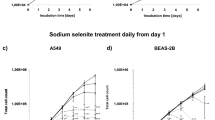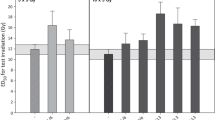Purpose:
To quantify the effect of sodium selenite (selenium) on radiation-induced oral mucositis (mouse) after subcutaneous or topical administration.
Material and Methods:
Mucosal ulceration of the lower epithelium of mouse tongue was analyzed. Selenium (5 μg) was applied subcutaneously (s.c.) or locally, 60 min or 30 min prior to irradiation, respectively. In combination with single-dose irradiation, a single selenium application was given. With daily fractionated irradiation (3 Gy/fraction) for 1 week (days 0–4), selenium was administered at all 5 days of irradiation. With ten fractions over 2 weeks, selenium was applied in week 1, week 2, or both. All fractionation protocols were terminated by graded test doses to generate full dose-effect curves.
Results:
In a single-dose control experiment, the ED50 (dose after which ulcer induction is expected in 50% of the mice) was 12.9 ± 1.6 Gy. Selenium increased the ED50 to 17.7 ± 2.6 Gy (s.c.; p = 0.0003) and 16.3 ± 3.0 Gy (local; p = 0.0104). The ED50 for test irradiation after 5 × 3 Gy was 7.4 ± 2.2 Gy. Subcutaneous administration of selenium resulted in an ED50 of 11.5 ± 2.0 Gy (p = 0.0015), local application yielded an ED50 of 10.0 ± 2.1 Gy (p = 0.0284). The ED50 for test irradiation after 10 × 3 Gy/2 weeks was 8.0 ± 1.7 Gy. Subcutaneous or local administration of selenium in week 1 yielded a significant increase in ED50 to 10.5 ± 1.0 Gy (p = 0.0069) and 10.7 ± 1.0 Gy (p = 0.0039), respectively. By clear contrast, selenium administration in week 2 had no significant effect. Administration in both weeks resulted in an ED50 of 9.1 ± 2.0 Gy (s.c.; p = 0.2747) and 9.7 ± 1.4 Gy (local; p = 0.0541).
Conclusion:
Administration of sodium selenite during clinically relevant fractionated irradiation protocols has a significant effect during the initial treatment phase, i.e., week 1 in the mouse. Therefore, in clinical radiotherapy, the latent time to manifestation of confluent mucositis may be significantly prolonged, and hence the burden for the patient clearly reduced by selenium.
Ziel:
Quantifizierung der Wirkung der subkutanen oder topischen Gabe von Natriumselenit (Selen) auf die strahleninduzierte Mukositis der Mundschleimhaut (Maus).
Material und Methodik:
Die Ulzeration der Schleimhaut der Zungenunterseite der Maus wurde analysiert. Selen (5 μg) wurde 60 min vor Bestrahlung subkutan (s.c.) oder 30 min vor Bestrahlung lokal appliziert. In Verbindung mit Einzeitbestrahlung wurde Selen einmalig gegeben. Bei täglich fraktionierter Bestrahlung (3 Gy/Fraktion) über 1 Woche (Tag 0–4) erfolgte die Selengabe an allen Bestrahlungstagen. Bei 2-wöchiger Fraktionierung wurde Selen in der 1. Woche, der 2. Woche oder in beiden Wochen appliziert. Alle Fraktionierungsprotokolle wurden durch eine Testbestrahlung mit gestaffelten Dosen abgeschlossen, um komplette Dosis-Effekt-Kurven zu generieren.
Ergebnisse:
Die alleinige Einzeitbestrahlung resultierte in einer ED50 (Dosis, bei der bei 50% der Tiere eine Ulzeration zu erwarten ist) von 12,9 ± 1,6 Gy. Die Selengabe erhöhte die ED50 auf 17,7 ± 2,6 Gy (s.c.; p = 0,0003) bzw. 16,3 ± 3,0 Gy (lokal; p = 0,0104). Die ED50 für die Testbestrahlung nach 5 × 3 Gy betrug 7,4 ± 2,2 Gy. Mit s.c. Applikation von Selen wurde eine ED50 von 11,5 ± 2,0 Gy (p = 0,0015) gefunden; bei lokaler Applikation ergab sich eine ED50 von 10,0 ± 2,1 Gy (p = 0,0284). Die ED50 für die Testbestrahlung nach 10 × 3 Gy/2 Wochen betrug 8,0 ± 1,7 Gy. Die s.c. bzw. lokale Selengabe in der 1. Woche erhöhte die ED50 signifikant auf 10,5 ± 1,0 Gy (p = 0,0069) bzw. 10,7 ± 1,0 Gy (p = 0,0039). Im Gegensatz dazu hatte die Selengabe in der 2. Bestrahlungswoche keinen signifikanten Effekt. Die Selenapplikation über beide Bestrahlungswochen ergab eine ED50 von 9,1 ± 2,0 Gy (s.c.; p = 0,2747) bzw. 9,7 ± 1,4 Gy (lokal; p = 0,0541).
Schlussfolgerung:
Die Verabreichung von Natriumselenit während klinisch relevanter, täglich fraktionierter Bestrahlungsprotokolle hat einen signifikanten Effekt während der ersten Phase der Bestrahlung, bei der Maus in der 1. Bestrahlungswoche. Klinisch besteht damit die Möglichkeit, dass die Latenzzeit bis zum Eintreten einer konfluenten Schleimhaut signifikant verlängert und damit die Belastung des Patienten durch Selen deutlich vermindert wird.
Similar content being viewed by others
Author information
Authors and Affiliations
Corresponding author
Rights and permissions
About this article
Cite this article
Gehrisch, A., Dörr, W. Effects of Systemic or Topical Administration of Sodium Selenite on Early Radiation Effects in Mouse Oral Mucosa. Strahlenther Onkol 183, 36–42 (2007). https://doi.org/10.1007/s00066-007-1594-4
Received:
Revised:
Issue Date:
DOI: https://doi.org/10.1007/s00066-007-1594-4




